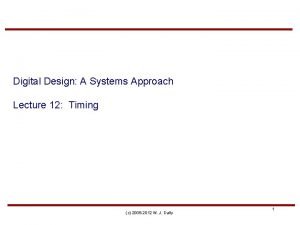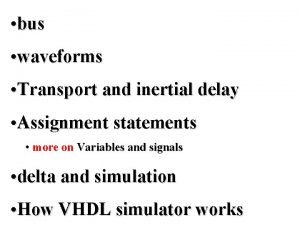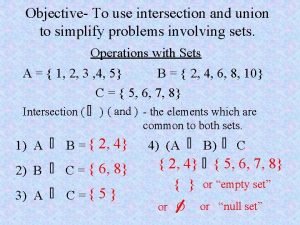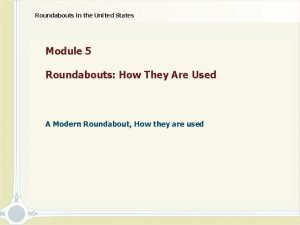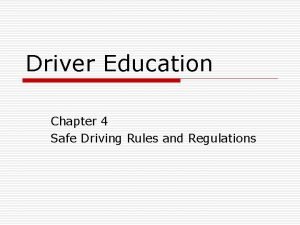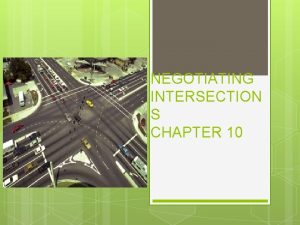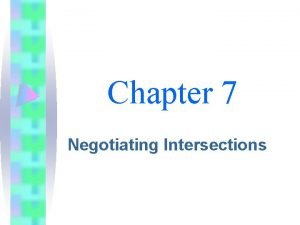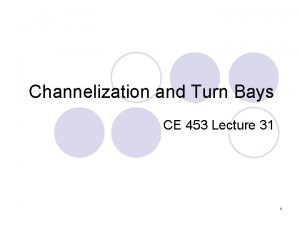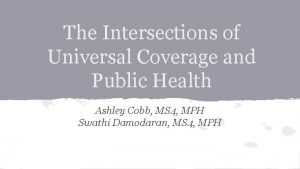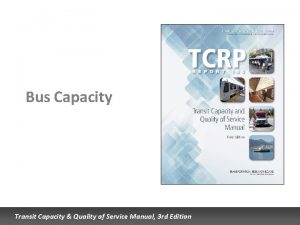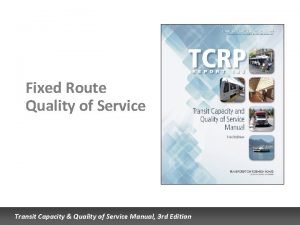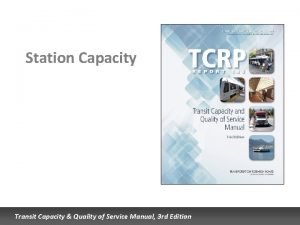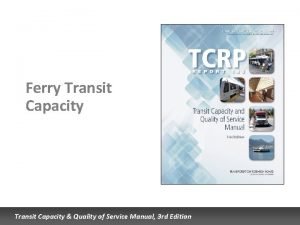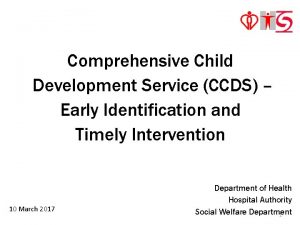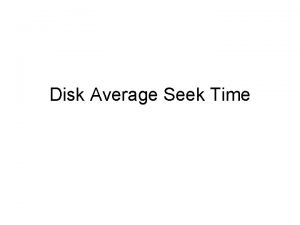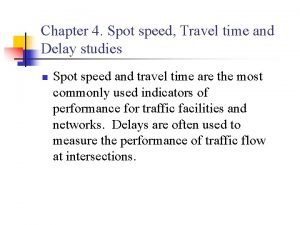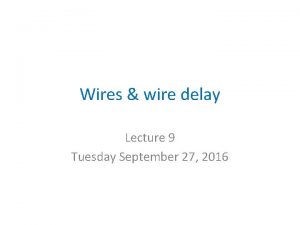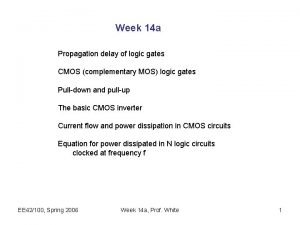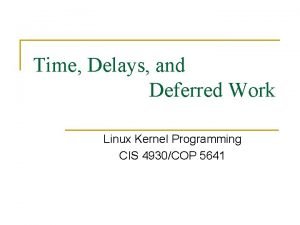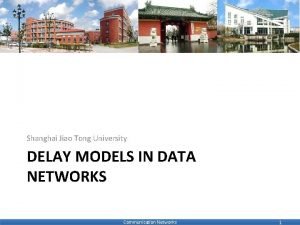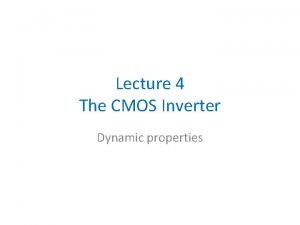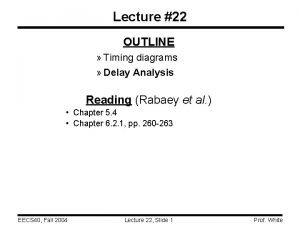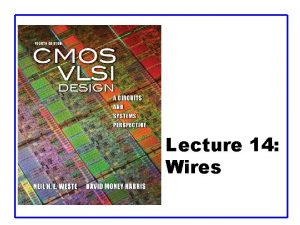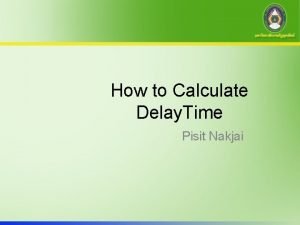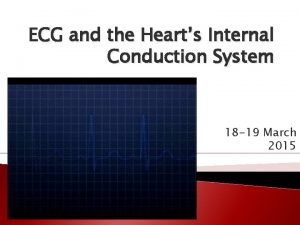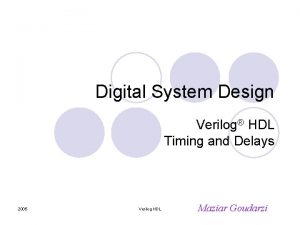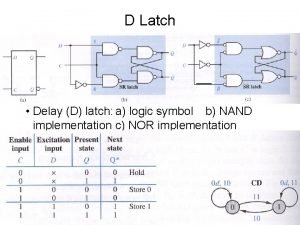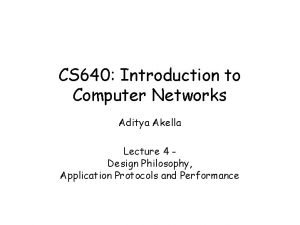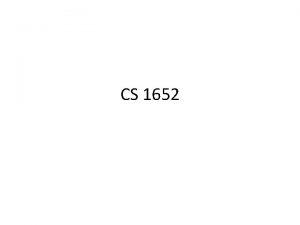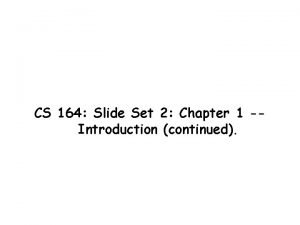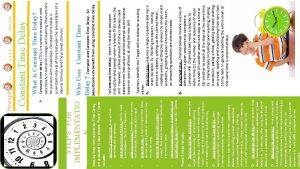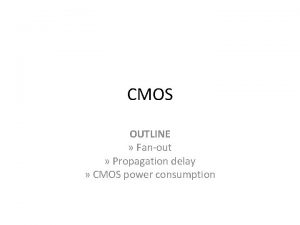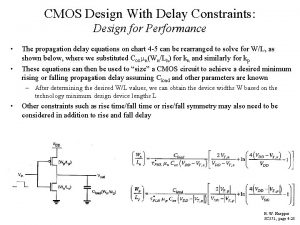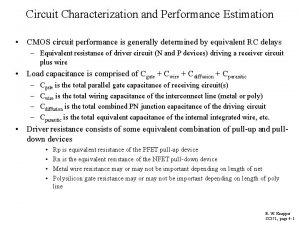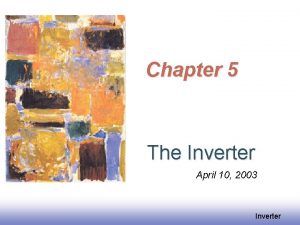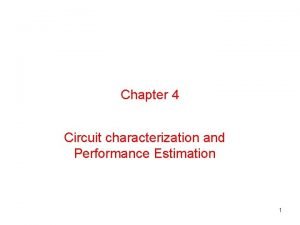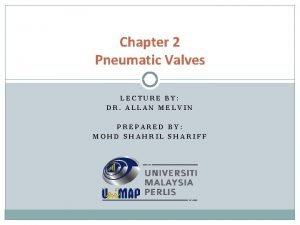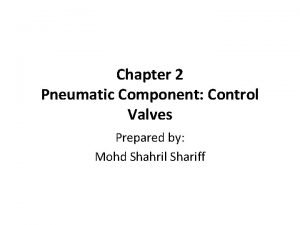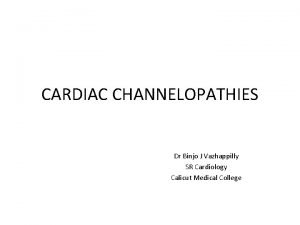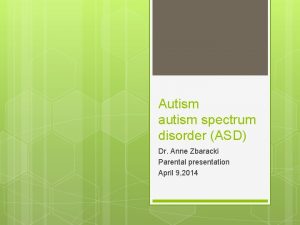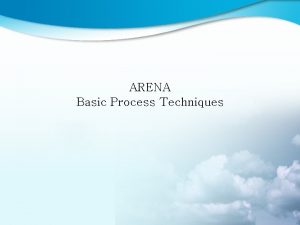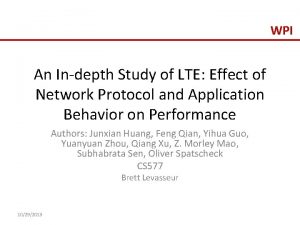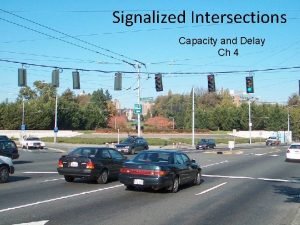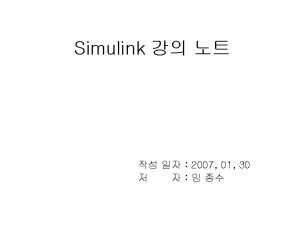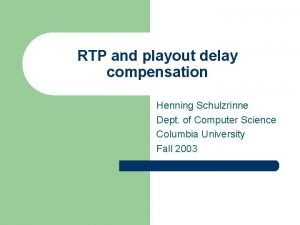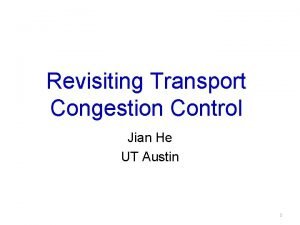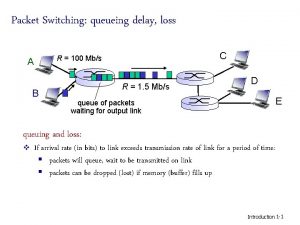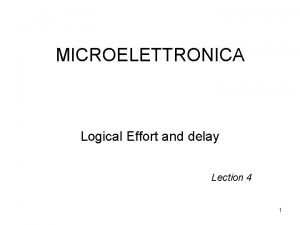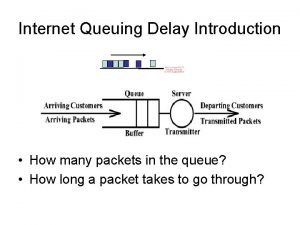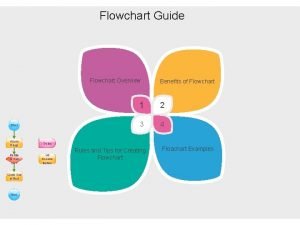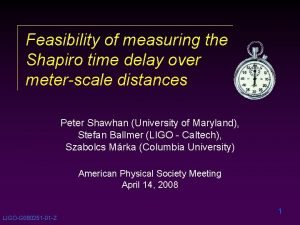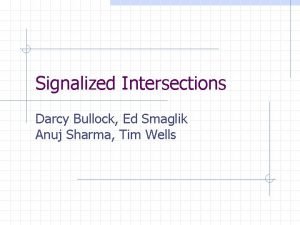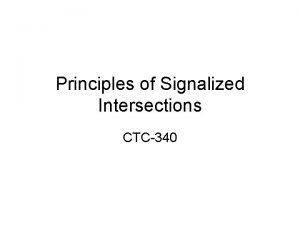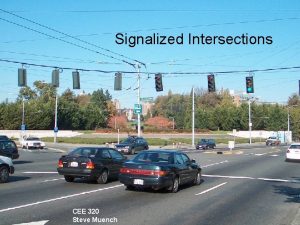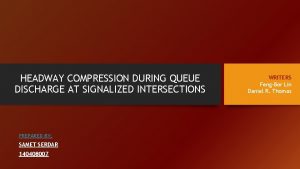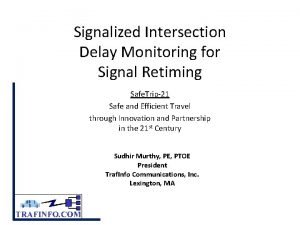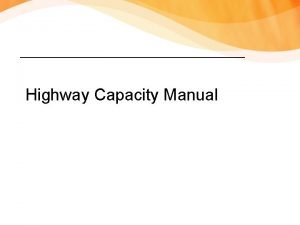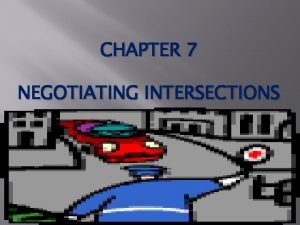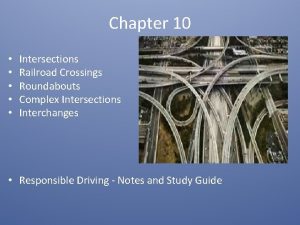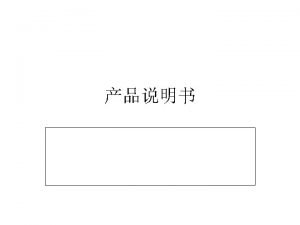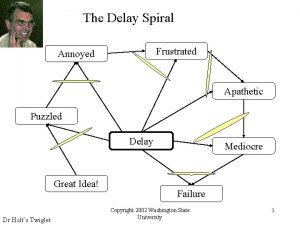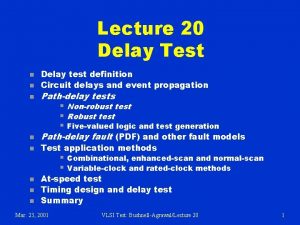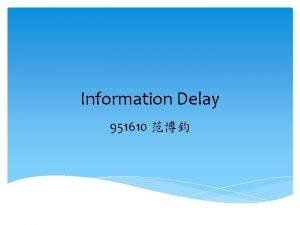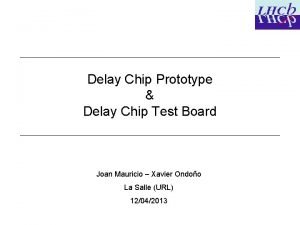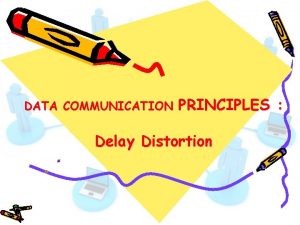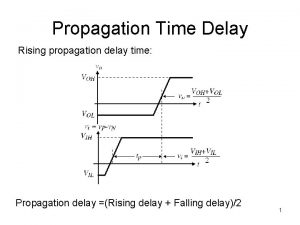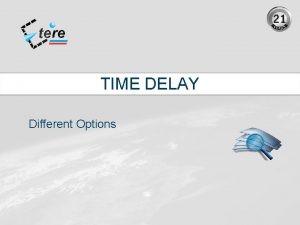Signalized Intersections Capacity and Delay Ch 4 Manual

































































- Slides: 65

Signalized Intersections Capacity and Delay Ch 4

Manual on Uniform Traffic Control (MUTCD) To be effective, a traffic-control device must: • Fulfill a need • Command attention • Convey a clear, simple meaning • Command the respect of road users • Give adequate time for proper response 2

Types of intersection Control -Yield Signs -Stop Signs -All way Stop Signs -Intersection Channelization -Traffic Signals -Interchange (Grade separated) 3

Signal warrants • Warrant 1, Eight-hour vehicular volume • Warrant 2, Four-hour vehicular volume • Warrant 3, Peak hour • Warrant 4, Pedestrian volume • Warrant 5, School crossing • Warrant 6, Coordinated signal system • Warrant 7, Crash experience • Warrant 8, Roadway network 4

5

6

Definitions Controller A device in a traffic signal installation that changes the colors indicated by the signal lamps according to a fixed or variable plan. Cycle (cycle length) The time in seconds required for one complete color sequence of signal indication. Phase (signal phase) That part of a cycle allocated to a stream of traffic or a combination of two or more streams of traffic having the right-of-way simultaneously during one or more intervals. 7

Definitions Saturation Flow Rate (s) Maximum flow that could pass through an intersection if 100% green time was allocated to that movement. S (vehicles/hour) = 3600/headway (seconds per vehicle) Approach Capacity (c) Saturation flow times the proportion of effective green c = s × g/C Offset The time lapse in seconds or the percentage of the cycle length between the beginning of a green phase at an intersection and the beginning of a corresponding green phase at the next intersection. It is the time base of the system controller. 8

Definitions Flow Ratio (q/s) The ratio of actual flow rate (q) to saturation flow rate (s) for a lane group at an intersection Lane Group A set of lanes established at an intersection approach for separate analysis Critical Lane Group The lane group that has the highest flow ratio (q/s) for a given signal phase ( requires the longest green time in a phase). Critical Volume-to-Capacity Ratio (Xc) The proportion of available intersection capacity used by vehicles in critical lane groups In terms of v/c and NOT q/s 9

Definitions Change and clearance interval The total length of time in seconds of the yellow and all-red signal indications. This time is provided for vehicles to clear the intersection after the green interval before conflicting movements are released. All-red interval The display time of a red indication for all approaches. It is sometimes used as a phase exclusively for pedestrian crossing or to allow vehicles and pedestrians to clear very large intersections before opposing approaches are given the green indication. 10

11 Two-Phase Signal System

Definitions Effective Green Time (Ge) Time effectively utilized for movement Ge= G + y + AR – t. L Effective Red Time (r) Time during which a movement is effectively not permitted to move. r = R + t. L r = C – Ge 12

Definitions Peak-hour factor (PHF). A measure of the variability of demand during the peak hour. 13

14

15

Fig. Typical Lane Groups for Analysis -Separate lane groups should be established for exclusive left 16 turn lane(s).

Saturation flow Ideal saturation flow (so)=1900 veh/h of green time per lane. 17

Signal Timing at Isolated Intersections Yellow Interval: is to alert motorists that the green light is about to change to red and to allow vehicles already in the intersection to cross it. 18

19

20

Types of Control 1. Fixed (Pretimed) Signals Fixed cycle length, Several timing options possible, need traffic history. 2. Semiactuated, 3. Fully actuated. 21

Pretimed Signals advantages and disadvantages: Advantages: Simple Can be coordinated Easy to field adjust Can handle peak and off peak condition Disadvantages: Cannot react to short term demand changes Can cause excessive delay Sometimes results in disrespect. 22

Semiactuated signal: Detectors on minor approaches. Fully actuated signal: Varying traffic demand Detectors on all approaches Maximum and minimum green times are set for each approach. 23

Cycle Lengths of Fixed (Pretimed) Signals Webster Method: q or v 24

lost time: 25

26

Allocation of Green Times. C : actual cycle length used (usually obtained by rounding off Co to the nearest five seconds). Gte (or gte) : total effective green time per cycle. 27

Minimum Green Time 28

29

30

Solution 31 equivalent hourly flows = peakhour volumes /PHF.

32

33

34

The Highway Capacity Method: The capacity of an approach or lane group is: 35

The ratio of flow to capacity (v/c) is usually referred to as the degree of saturation : 36

The critical v/c ratio for the whole intersection is : 37

38

39

40

41

42

43

44

Movements Protected movement: A movement that has the right-of-way and does not need to yield to conflicting movements, such as opposing vehicle traffic or pedestrians. Permitted movement: A movement that must yield to opposing traffic flow or conflicting pedestrian movements. 45

Operational Analysis Procedure When long delays occur at (v/c) ratios less than 1, it may be due to a combination of two or more of the following conditions. • Long cycle lengths • Green time is not properly distributed, resulting in a longer red time for one or more lane groups. • A poor signal progression, (large percentage of the vehicles on the approach arriving during the red phase). It is also possible to have short delays at an approach when the (v/c) ratio equals 1. • Short cycle length • Favorable signal progression, resulting in a high percentage of vehicles arriving during the green phase 46

Clearly, LOS F does not necessarily indicate that the intersection, approach, or lane group is oversaturated, nor can it automatically be assumed that the demand flow is below capacity for a LOS range of A to E. 47

Baseline Assumptions - D/D/1 queuing - Approach arrivals < departure capacity (no queue exists at the beginning/end of a cycle) 48

D/D/1 Signal Analysis (Graphical) Vehicles Departure Rate Arrival Rate Queue dissipation Total vehicle delay per cycle (Dt) Maximum delay Maximum queue Time 49 Red Green

D/D/1 Signal Analysis – Numerical Time to queue dissipation after the start of effective green Maximum number of vehicles in a queue 50

D/D/1 Signal Analysis – Numerical Total delay per cycle Average vehicle delay per cycle Maximum delay of any vehicle (assume FIFO) 51

Signal Analysis – Random Arrivals Webster’s Formula (1958) - empirical d’ = avg. veh. delay assuming random arrivals d = avg. veh. delay assuming uniform arrivals (D/D/1) =Dt/ lc x = ratio of arrivals to departures (lc/mg) g = effective green time (sec) c = cycle length (sec) 52

Approach Delay 53

Intersection Delay 54

Definition – Level of Service (LOS) Chief measure of “quality of service” - Describes operational conditions within a traffic stream - Does not include safety - Different measures for different facilities Six levels of service (A through F) 55

Signalized Intersection LOS Based on control delay per vehicle -How long you wait, on average, at the stop light 56 from Highway Capacity Manual 2000

The “Art” of Signal Optimization Long Cycle Length -High capacity (reduced lost time) -High delay on movements that are not served Short Cycle Length -Reduced capacity (increased lost time) -Reduced delay for any given movement 57

Additional Example An intersection operates using a simple 3 -phase design as pictured. SB WB EB 58 Phase Lane group Saturation Flows 1 SB 3400 veh/hr 2 NB 3400 veh/hr 3 EB 1400 veh/hr WB 1400 veh/hr NB

Example What is the sum of the flow ratios for the critical lane groups? What is the total lost time for a signal cycle assuming 2 seconds of clearance lost time and 2 seconds of startup lost time per phase? SB Using 3 phases 30 EB 400 30 200 300 20 1000 50 100 59 150 NB WB

PHASE 1: SB Th/left/right= (400+150+30)/3400 = 0. 171 PHASE 2 NB Th/left/right = (1000+100+50)/3400 = 0. 338 PHASE 3 EB Th/right = (200+20)/1400 = 0. 157 WB Th/right = (300+30)/1400 = 0. 236 limiting since v/s is highest Σ(v/s) ci = ΣYci = 0. 171 + 0. 338 + 0. 236 = 0. 745 60 Total lost time = 3(2+2) = 12 seconds

Cont. Example Calculate an optimal signal timing (rounded up to the nearest 5 seconds) using Webster’s formula. Co= 1. 5(12 sec) + 5/(1 -0. 745) = 90. 2 seconds C = 95 seconds (rounded up to nearest 5 seconds) 61

Solution DETERMINE Xc Xc = 0. 745(95)/(95 – 12) = 0. 853 CALCULATE EFFECTIVE GREEN TIMES g. SB = 0. 171(95/0. 853) = 19. 04 seconds g. NB = 0. 338(95/0. 853) = 37. 64 seconds g. EBWB = 0. 236 (95/0. 853) = 26. 28 seconds CHECK 19. 04 + 37. 64 + 26. 28 + 12 = 94. 96 = 95 seconds ACTUAL GREEN TIMES In this case, they are the same as g G = g+e-l 1 = g +2 -2 = g 62

Cont. Example Is this signal adequate for pedestrians? A pedestrian count showed 5 pedestrians crossing the EB and WB lanes on each side of the intersection and 10 pedestrians crossing the NB and SB crosswalks on each side of the intersection. Lanes are 12 ft. wide. The effective crosswalk widths are all 10 ft. Ped on EB/WB: Gp = 3. 2 + 24/4 + 0. 27(5) = 10. 55 seconds Ok NB/SB Gp = 3. 2 + 48/4 + 0. 27(10) = 17. 90 seconds , 26. 28 sec. > 17. 9 OK 63

Cont. Example What is the intersection Level of Service (LOS)? 64

Intersection Control Type 65 from Highway Capacity Manual 2000
 Propagation delay
Propagation delay Difference between signal and variable in vhdl
Difference between signal and variable in vhdl Normally open timer symbol
Normally open timer symbol Why are most roadways crowned?
Why are most roadways crowned? Union vs intersection
Union vs intersection Module 5 intersections and roundabouts
Module 5 intersections and roundabouts Chapter 4 safe driving rules and regulations
Chapter 4 safe driving rules and regulations Design capacity and effective capacity examples
Design capacity and effective capacity examples Negotiating intersections chapter 10
Negotiating intersections chapter 10 An uncontrolled railroad crossing
An uncontrolled railroad crossing Chapter 7 negotiating intersections
Chapter 7 negotiating intersections Turn bays
Turn bays Chapter 7 negotiating intersections
Chapter 7 negotiating intersections Chapter 7 negotiating intersections
Chapter 7 negotiating intersections Transit capacity and quality of service manual
Transit capacity and quality of service manual Transit capacity and quality of service manual
Transit capacity and quality of service manual Transit capacity and quality of service manual
Transit capacity and quality of service manual Transit capacity manual
Transit capacity manual Manual of parenting capacity assessment framework swd
Manual of parenting capacity assessment framework swd Average seek time in disk scheduling
Average seek time in disk scheduling Travel time and delay studies
Travel time and delay studies Delay and dispute mitigation
Delay and dispute mitigation Delay and sum beamforming
Delay and sum beamforming Distributed rc delay model
Distributed rc delay model Propagation delay
Propagation delay Tasklet_hi_schedule
Tasklet_hi_schedule Delay models in data networks
Delay models in data networks Ideal inverter
Ideal inverter Propagation delay timing diagram
Propagation delay timing diagram Distributed rc delay model
Distributed rc delay model Decfsz
Decfsz Don't delay dawns disarming display. dusk demands daylight
Don't delay dawns disarming display. dusk demands daylight Av node delay
Av node delay Turn off delay in verilog
Turn off delay in verilog Latch delay
Latch delay Bandwidth-delay product
Bandwidth-delay product Bandwidth-delay product
Bandwidth-delay product Bandwidth-delay product
Bandwidth-delay product Ctd procedure
Ctd procedure Cmos power consumption
Cmos power consumption Propagation delay formula
Propagation delay formula Circuit characterization
Circuit characterization Propagation delay formula
Propagation delay formula Parking study in traffic engineering
Parking study in traffic engineering Elmore
Elmore A shuttle valve exhausts an air pilot of a dcv when
A shuttle valve exhausts an air pilot of a dcv when Pneumatic control valve function
Pneumatic control valve function Delay after depolarization
Delay after depolarization Global developmental delay symptoms
Global developmental delay symptoms 아레나 시뮬레이션 예제
아레나 시뮬레이션 예제 Arduino komutları
Arduino komutları Adaptations without delay
Adaptations without delay Queuing delay
Queuing delay Channelization
Channelization Unit delay in simulink
Unit delay in simulink Playout delay
Playout delay Queuing delay
Queuing delay Caravan analogy
Caravan analogy Game maker delay
Game maker delay Effort delay
Effort delay Windows analysis delay method
Windows analysis delay method Queuing delay
Queuing delay Queuing delay
Queuing delay Powerpoint animation delay more than 60 seconds
Powerpoint animation delay more than 60 seconds Alarm clock flowchart
Alarm clock flowchart Shapiro time delay
Shapiro time delay
